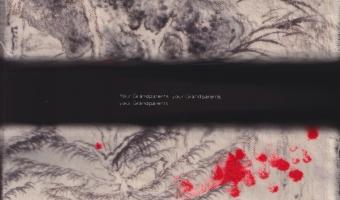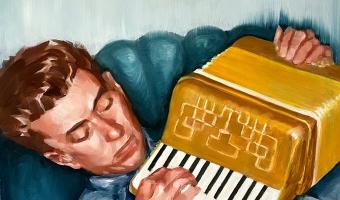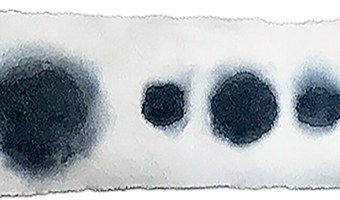Life Forms From Death by: Maria Rutigliano
My first encounter with death was at 18 years old. Three family deaths in less than three months left me both anxious and numb to the idea of loss. I have since been confused with my own emotions about death and have not had to deal with another death since. I chose to channel my anxiety and use it to my advantage for my thesis work. I am interested in trying to figure out if there is potential for life to evolve again from the decaying process.
My work from my second year at OCADU has influenced how I approached my thesis. I am using the same methodologies that I had used then. I work in a very mental emotional state. Using the paint as fluidly as possible, I mix all my colours directly on the canvas, a la prima. There is a lot of layering involved and using acrylic paint allows me to bring other non-paint materials into my work. The goal is to convey a chaotic atmosphere that resigantes the layers and emotional state that went into the paintings. My work explores ideas of growth from decay, life evolving from death.Using opposing colour pallets, I create dark atmospheres that neon colour emerges from. Creating a light in the dark, a growth of new life. These mixed media paintings combine acrylic paint, linens, oil pastels and paper. The textured materials emphasize tactility, the idea of life on the canvas.
There is symbolism that can be found consistently throughout my body of work. To display the idea of life I have used abstracted imagery of butterflies, the bodies of snakes, and flowers. These are direct references to reincarnation, the earth and fertility and the idea of this life cycle never ending; we are born, we grow, we die and are placed into the earth where we evolve again from the earth, to life. In a way my work can be read as spiritual as I have also grouped marks and textures in my work in threes. Three is a biblical number that is associated with there being three births and three deaths almost always cohesively. This body of work, Life Forms From Death (2020-21) will hopefully bring a sense of security in the idea that there is more in store after our darkest hour reaches.
My work from my second year at OCADU has influenced how I approached my thesis. I am using the same methodologies that I had used then. I work in a very mental emotional state. Using the paint as fluidly as possible, I mix all my colours directly on the canvas, a la prima. There is a lot of layering involved and using acrylic paint allows me to bring other non-paint materials into my work. The goal is to convey a chaotic atmosphere that resigantes the layers and emotional state that went into the paintings. My work explores ideas of growth from decay, life evolving from death.Using opposing colour pallets, I create dark atmospheres that neon colour emerges from. Creating a light in the dark, a growth of new life. These mixed media paintings combine acrylic paint, linens, oil pastels and paper. The textured materials emphasize tactility, the idea of life on the canvas.
There is symbolism that can be found consistently throughout my body of work. To display the idea of life I have used abstracted imagery of butterflies, the bodies of snakes, and flowers. These are direct references to reincarnation, the earth and fertility and the idea of this life cycle never ending; we are born, we grow, we die and are placed into the earth where we evolve again from the earth, to life. In a way my work can be read as spiritual as I have also grouped marks and textures in my work in threes. Three is a biblical number that is associated with there being three births and three deaths almost always cohesively. This body of work, Life Forms From Death (2020-21) will hopefully bring a sense of security in the idea that there is more in store after our darkest hour reaches.




